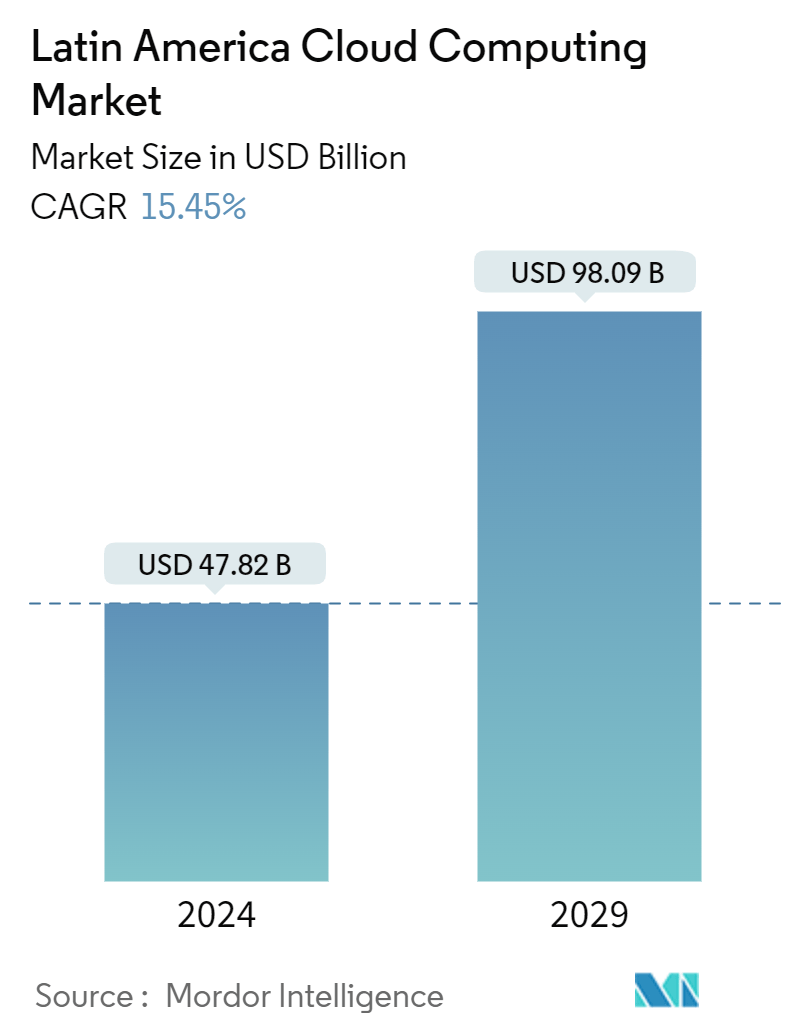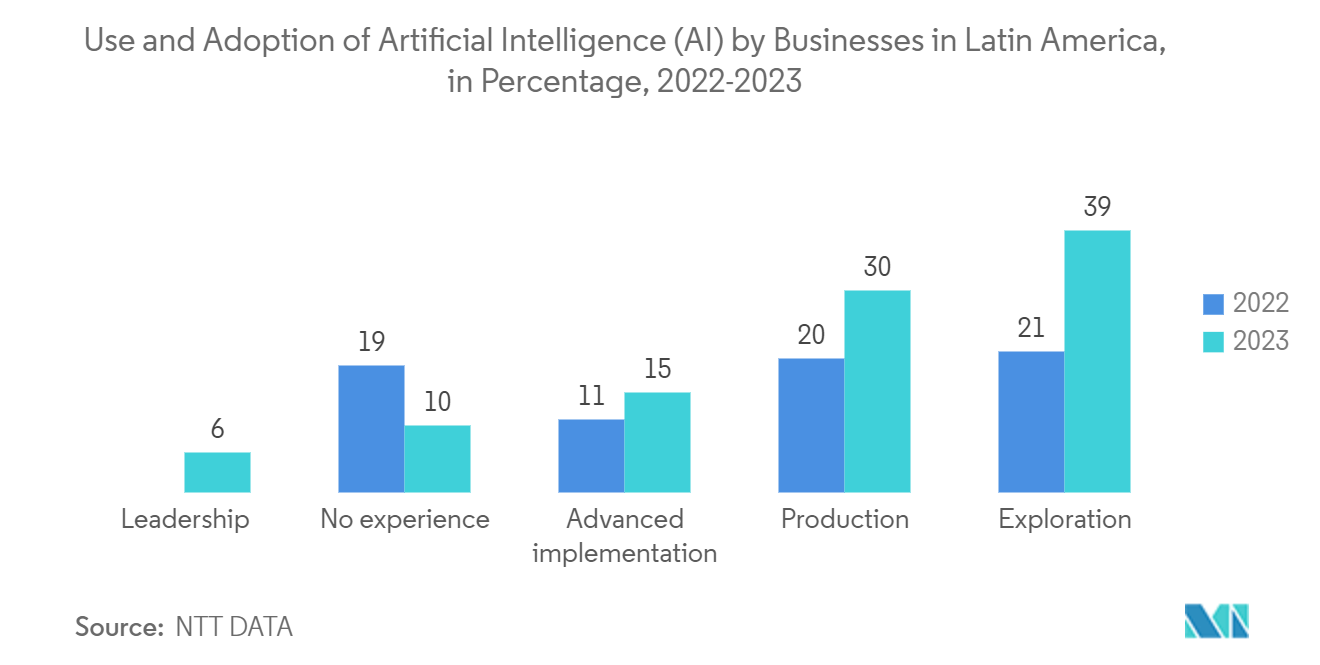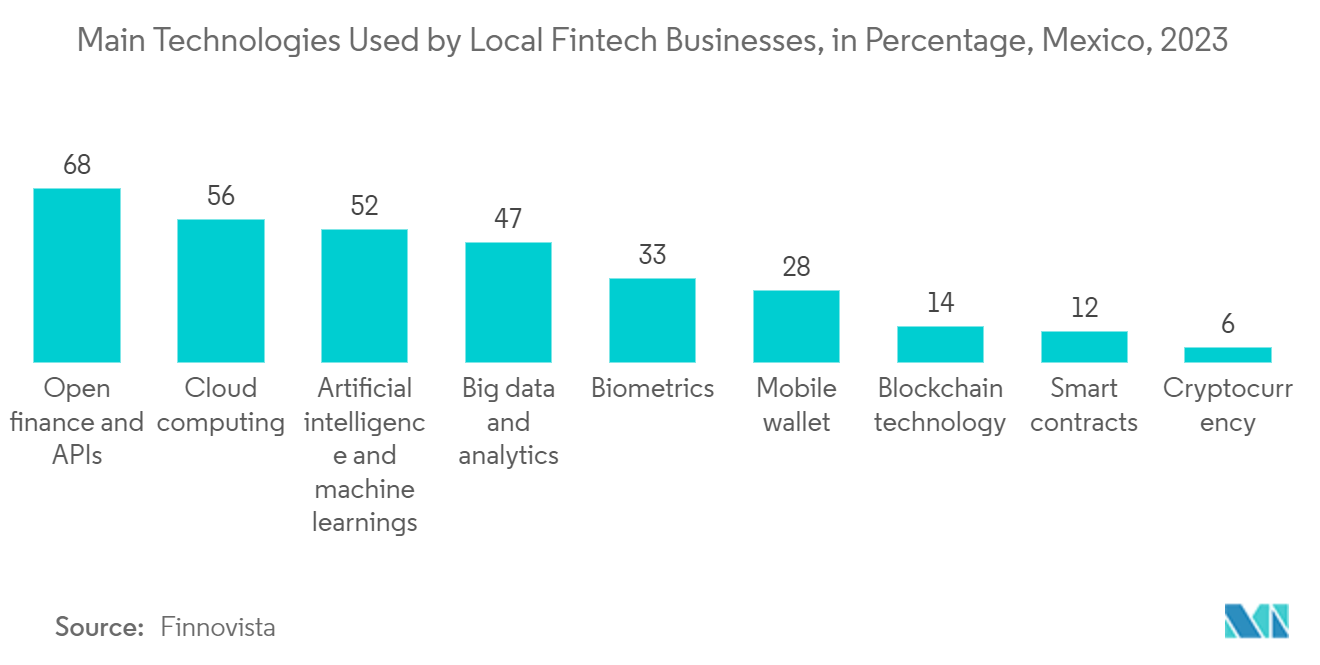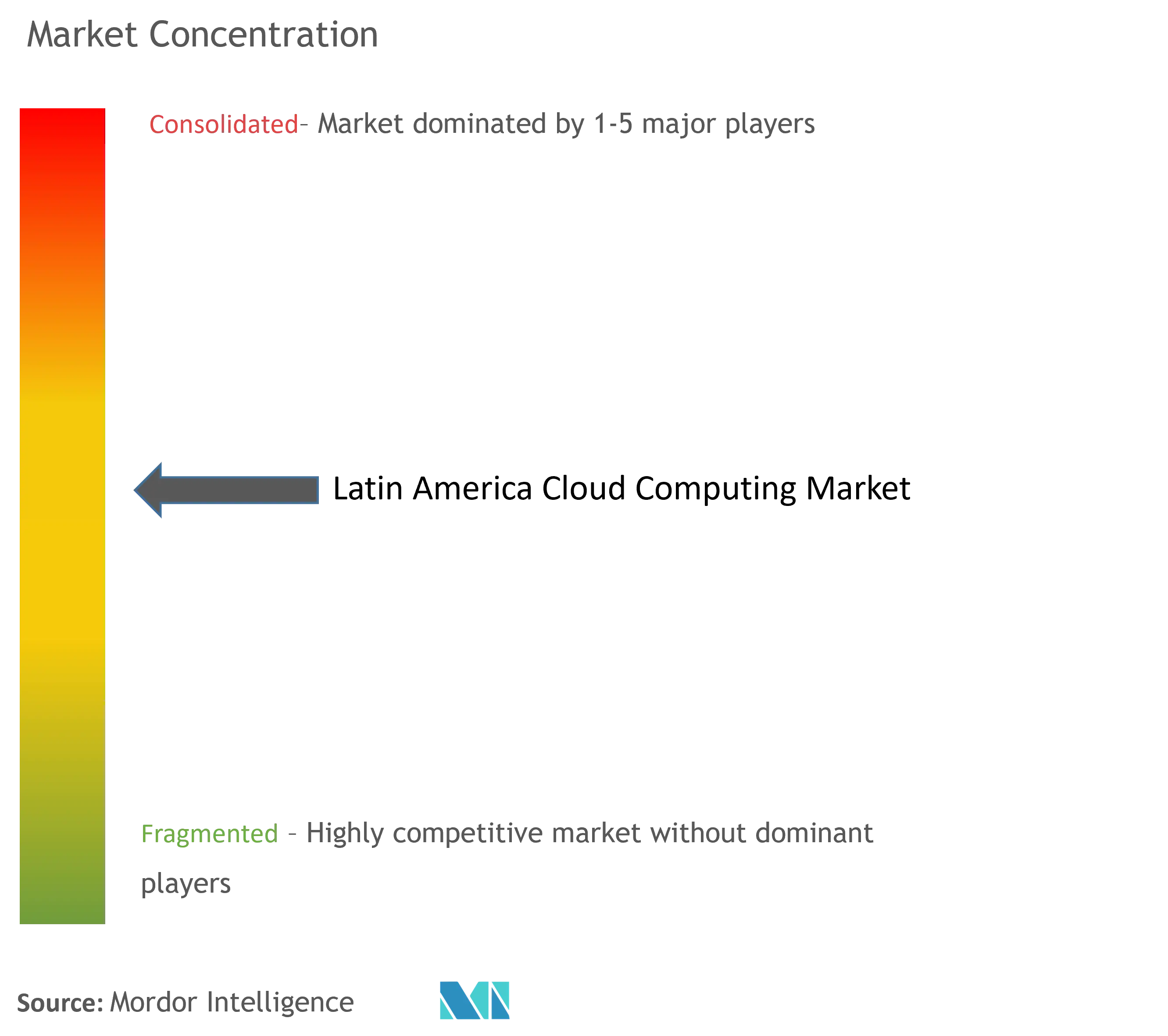Latin America Cloud Computing Market Size

| Study Period | 2019 - 2029 |
| Base Year For Estimation | 2023 |
| Market Size (2024) | USD 47.82 Billion |
| Market Size (2029) | USD 98.09 Billion |
| CAGR (2024 - 2029) | 15.45 % |
| Market Concentration | Medium |
Major Players
*Disclaimer: Major Players sorted in no particular order |
Latin America Cloud Computing Market Analysis
The Latin America Cloud Computing Market size is estimated at USD 47.82 billion in 2024, and is expected to reach USD 98.09 billion by 2029, growing at a CAGR of 15.45% during the forecast period (2024-2029).
- Cloud computing is transforming business operations across Latin American countries, offering solutions that are flexible, scalable, and cost-effective. In the region, organizations are increasingly adopting cloud services, acknowledging their potential to boost operations and foster innovation. Furthermore, the presence of prominent cloud computing vendors in Latin America, combined with the growing adoption of cloud computing by businesses, is fueling the market's expansion.
- The Latin American cloud computing market is expanding due to several key drivers. These include a surge in digital transformation efforts, heightened demand for remote collaboration tools, and the adoption of cutting-edge technologies such as artificial intelligence and the Internet of Things. The region is set to harness the full potential of cloud services owing to the growing tech-savvy populace, rising internet access, and proactive government measures supporting digitalization and cloud adoption, thus positively supporting the growth of the market.
- Countries in the Latin America region have crafted tailored strategies, harnessing the advantages of digitalization in their planning. National digital strategies have emerged, including Argentina's Digital Agenda, Brazil's Digital Government Strategy, Chile's Digital Transformation of the State, Colombia's ICT Plan, and Mexico's National Digital Strategy. For instance, Chile's "Digital 2035" initiative aims for a 95% digitalization target for both government and businesses by 2025, escalating to 100% by 2035.
- This has spurred a migration toward cloud technologies, integrating advanced tools like AI, big data, and the Internet of things, driving the demand for cloud computing resources. Notably, Brazil's digital transformation blueprint emphasizes heightened investments and the adoption of cloud and AI technologies, aiming for a comprehensive digital overhaul in the coming decade. Such developments further shape the future of the cloud computing market in Latin American countries.
- In the coming years, Latin American countries are poised to witness a rapid surge in cloud computing growth. This momentum is largely fueled by a rising demand for cloud-based services among enterprises, the burgeoning digital economy, the integration of AI, and the rollout of 5G. Latin American countries' strategic position as economic hubs, coupled with advanced telecommunications infrastructure and robust fiber optic connectivity, was further analyzed to bolster this trend.
Latin America Cloud Computing Market Trends
Large Enterprises Are Expected to Hold a Significant Market Share
- Large enterprises in Latin America are rapidly driving the demand for cloud computing. This surge is fueled by factors like rapid digital transformation and increased adoption of advanced technologies, including artificial intelligence, machine learning, and the Internet of Things (IoT). Moreover, the various benefits of cloud adoption, such as flexibility and scalability, bolster this growing demand among major businesses in the region.
- Moreover, over the past two years, large companies in Latin America have rapidly adopted artificial intelligence (AI) technologies. This uptick in AI adoption, particularly among the region's large enterprises, has heightened the demand for cloud computing. Cloud platforms, with their on-demand access to virtually limitless computing power, empower organizations to scale their AI initiatives effectively. Such factors are analyzed to bolster the demand for cloud computing in large enterprises across the region.
- A 2023 survey conducted by NTT DATA revealed that almost 40% of business leaders in Latin America were investigating AI solutions for their companies, marking an 18% rise from the previous year. In contrast, only 10% of respondents reported a lack of AI experience in 2023, down by 9% from 2022.
- As AI adoption surges across various industries in Latin America, global cloud computing vendors are increasingly establishing a foothold in the region to meet the escalating demand for cloud services. For example, in May 2024, Chinese cloud giant Alibaba announced its intention to broaden its reach in Mexico while simultaneously augmenting its cloud regions in the APAC markets. The president of international business at Alibaba Cloud Intelligence stated that in response to the rapidly growing AI demand across sectors, Alibaba Cloud is doubling down on its commitment to bolster its AI infrastructure and elevate its global cloud capabilities.
- In June 2024, Amazon Web Services (AWS) received approval to establish its inaugural data center in Chile. This USD 205 million venture signifies a pivotal step in the company's South American expansion, underscoring the growing demand for cloud services in the continent. Positioned in the Santiago Metropolitan Region, the data center will deliver a comprehensive range of AWS cloud services, encompassing computing, storage, networking, analytics, and artificial intelligence. This initiative empowers Chilean enterprises and institutions with state-of-the-art cloud infrastructure, fostering innovation, operational scalability, and enhanced efficiency.
- In February 2024, Amazon Web Services Mexico (AWS), a subsidiary of Amazon.com Inc., revealed plans to invest over USD 5 billion in establishing a data center cluster in Mexico. This move comes in response to the surging demand for cloud services as businesses increasingly adopt new technologies.

Mexico Is Expected to Hold Significant Market Share
- In Mexico, demand for cloud-based infrastructure and services is surging, fueled by businesses increasingly adopting digital transformation strategies. This momentum is likely to persist as more companies adopt remote work and digital operations. Moreover, government initiatives promoting cloud computing, coupled with investments in infrastructure, are propelling the market's expansion.
- Moreover, the data center expansion by major cloud providers, such as Google and Microsoft Corporation, as well as regional cloud computing vendors in Mexico, is analyzed to bolster the adoption of cloud computing among businesses in the country. For instance, in February 2024, ODATA, a company under Aligned Data Centers and a key player in providing data center services across Latin America, announced its operational expansion in Mexico. The QR01 data center, situated in the strategic location of Querétaro, is set to undergo an expansion to cater to the surging demand for IT infrastructure and cloud services in the region.
- Moreover, many companies from a wide range of industries in Mexico are seeking to scale their operations, enhance efficiency, and cut costs by transitioning to cloud services, with a variety of international providers available. Furthermore, Mexico's financial services and fintech industry is increasingly adopting cloud computing. This trend is driven by companies' desires to cut costs, enhance scalability, and leverage new technologies.
- As a result, the BFSI sector in Mexico is poised to significantly boost the demand for cloud computing. For instance, Finnovista reported that in 2023, nearly 70% of fintechs in Mexico adopted open finance and APIs, establishing them as the predominant technologies in the fintech sector. Additionally, cloud computing, AI, and machine learning gained significant traction, with over half of all fintech businesses leveraging these technologies.

Latin America Cloud Computing Industry Overview
The Latin American cloud computing market is semi-consolidated, with some of the major cloud computing market vendors holding a significant share of the market. Market players are advancing their cloud infrastructure and data center investments in the region to expand their market share. In addition, the partnership, acquisition, and merger activities are shaping the competitive landscape of the Latin American cloud computing market.
Latin America Cloud Computing Market Leaders
-
Microsoft Corporation
-
Huawei Technologies Co., Ltd.
-
Google LLC (Alphabet Inc.)
-
IBM Corporation
-
Amazon Web Services (AWS)
*Disclaimer: Major Players sorted in no particular order

Latin America Cloud Computing Market News
- March 2024: Sangfor Technologies, a global player in cybersecurity and cloud computing solutions, announced its expansion into Brazil and Colombia. This move underscores Sangfor's dedication to global growth and the provision of advanced technology solutions. By setting up local teams and forging partnerships, Sangfor Technologies is strategically positioned to replicate its success in Brazil and Colombia. In Brazil, the company has teamed up with a prominent local distributor, ensuring that its advanced cybersecurity and cloud computing solutions are readily available to local enterprises.
- January 2024: GFT Technologies SE, through its wholly-owned subsidiary GFT Technologies SA, entered into an agreement to acquire all shares of Sophos Solutions SAS, headquartered in Bogotá, Colombia. Sophos stands out as a prominent partner for the digital transformation of major financial institutions across North and South America, especially in Colombia. The firm is adept at modernizing core banking systems and cloud computing and boasts a workforce of over 1,700 employees. By acquiring Sophos, GFT is bolstering its international footprint by establishing a new development center and enhancing its access to Tier 1 and Tier 2 financial institutions throughout Latin America.
Latin America Cloud Computing Market Report - Table of Contents
1. INTRODUCTION
- 1.1 Study Assumptions and Market Definition
- 1.2 Scope of the Study
2. RESEARCH METHODOLOGY
3. EXECUTIVE SUMMARY
4. MARKET INSIGHTS
- 4.1 Market Overview
-
4.2 Industry Attractiveness - Porter's Five Forces Analysis
- 4.2.1 Bargaining Power of Suppliers
- 4.2.2 Bargaining Power of Buyers
- 4.2.3 Threat of New Entrants
- 4.2.4 Threat of Substitutes
- 4.2.5 Intensity of Competitive Rivalry
- 4.3 Assessment of Macro Economic Trends on the Cloud Computing Landscape
- 4.4 Technology Landscape
- 4.5 Industry Regulations and Standards
5. MARKET DYNAMICS
-
5.1 Market Drivers
- 5.1.1 Latin America’s Government Supportive Policies on Cloud Computing
- 5.1.2 Rising Enterprise Demand for Cloud Services
-
5.2 Market Challenges
- 5.2.1 Data Privacy and Security Issues
- 5.3 Case Study Analysis
- 5.4 Pricing Model Analysis
6. MARKET SEGMENTATION
-
6.1 By Type
- 6.1.1 Public Cloud
- 6.1.1.1 IaaS
- 6.1.1.2 PaaS
- 6.1.1.3 SaaS
- 6.1.2 Private Cloud
- 6.1.3 Hybrid Cloud
-
6.2 Organization Size
- 6.2.1 SMEs
- 6.2.2 Large Enterprises
-
6.3 End-user Industries
- 6.3.1 Manufacturing
- 6.3.2 Education
- 6.3.3 Retail
- 6.3.4 Transportation and Logistics
- 6.3.5 Healthcare
- 6.3.6 BFSI
- 6.3.7 Telecom and IT
- 6.3.8 Government and Public Sector
- 6.3.9 Others (Utilities, Media and Entertainment, etc.)
-
6.4 Country***
- 6.4.1 Brazil
- 6.4.2 Mexico
- 6.4.3 Argentina
- 6.4.4 Colombia
7. COMPETITIVE LANDSCAPE
-
7.1 Company Profiles*
- 7.1.1 Microsoft Corporation
- 7.1.2 Amazon Web Services (AWS)
- 7.1.3 Google LLC (Alphabet Inc.)
- 7.1.4 IBM Corporation
- 7.1.5 Huawei Technologies Co. Ltd
- 7.1.6 Oracle Corporation
- 7.1.7 Tencent Holdings Ltd
- 7.1.8 Salesforce Inc.
- 7.1.9 SAP SE
8. INVESTMENT ANALYSIS
9. FUTURE MARKET OUTLOOK
** Subject To AvailablityLatin America Cloud Computing Industry Segmentation
Cloud computing offers a vast range of computing services over the Internet. These services include servers, storage, databases, networking, software, analytics, and intelligence. Key advantages of cloud computing are accelerated innovation, flexible resource allocation, and economies of scale. Customers generally pay only for the services they use. This approach cuts operational costs, boosts infrastructure efficiency, and enables scaling to meet changing business demands.
The Latin American cloud computing market is segmented by type (public cloud [IaaS, PaaS, SaaS], private cloud, and hybrid cloud), organization size (SMEs and large enterprises), end-user industries (manufacturing, education, retail, transportation and logistics, healthcare, BFSI, telecom and IT, government and public sector, others [utilities, media and entertainment, etc.]), and country (Brazil, Mexico, Argentina, Colombia, and Rest of Latin America). The market size and forecasts are provided in terms of value (USD) for all the above segments.
| By Type | Public Cloud | IaaS |
| PaaS | ||
| SaaS | ||
| By Type | Private Cloud | |
| Hybrid Cloud | ||
| Organization Size | SMEs | |
| Large Enterprises | ||
| End-user Industries | Manufacturing | |
| Education | ||
| Retail | ||
| Transportation and Logistics | ||
| Healthcare | ||
| BFSI | ||
| Telecom and IT | ||
| Government and Public Sector | ||
| Others (Utilities, Media and Entertainment, etc.) | ||
| Country*** | Brazil | |
| Mexico | ||
| Argentina | ||
| Colombia |
Latin America Cloud Computing Market Research FAQs
How big is the Latin America Cloud Computing Market?
The Latin America Cloud Computing Market size is expected to reach USD 47.82 billion in 2024 and grow at a CAGR of 15.45% to reach USD 98.09 billion by 2029.
What is the current Latin America Cloud Computing Market size?
In 2024, the Latin America Cloud Computing Market size is expected to reach USD 47.82 billion.
Who are the key players in Latin America Cloud Computing Market?
Microsoft Corporation, Huawei Technologies Co., Ltd., Google LLC (Alphabet Inc.), IBM Corporation and Amazon Web Services (AWS) are the major companies operating in the Latin America Cloud Computing Market.
What years does this Latin America Cloud Computing Market cover, and what was the market size in 2023?
In 2023, the Latin America Cloud Computing Market size was estimated at USD 40.43 billion. The report covers the Latin America Cloud Computing Market historical market size for years: 2019, 2020, 2021, 2022 and 2023. The report also forecasts the Latin America Cloud Computing Market size for years: 2024, 2025, 2026, 2027, 2028 and 2029.
Latin America Cloud Computing Industry Report
Statistics for the 2024 Latin America Cloud Computing market share, size and revenue growth rate, created by Mordor Intelligence™ Industry Reports. Latin America Cloud Computing analysis includes a market forecast outlook for 2024 to 2029 and historical overview. Get a sample of this industry analysis as a free report PDF download.



